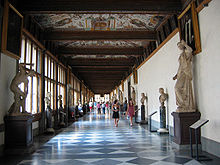Florence has a legendary artistic heritage. Cimabue and Giotto, the fathers of Italian painting, lived in Florence as well as Arnolfo and Andrea Pisano, renewers of architecture and sculpture; Brunelleschi, Donatello and Masaccio, forefathers of the Renaissance, Ghiberti and the Della Robbias, Filippo Lippi and Angelico; Botticelli, Paolo Uccello and the universal genius of Leonardo da Vinci and Michelangelo.
Their works, together with those of many other generations of artists, are gathered in the several museums of the town: the Uffizi Gallery, the Palatina gallery with the paintings of the "Golden Ages" the Bargello with the sculptures of the Renaissance, the museum of San Marco with Fra Angelico's works, the Academy, the chapels of the Medicis
Buonarroti' s house with the sculptures of Michelangelo, the following museums: Bardini, Horne, Stibbert, Romano, Corsini, The Gallery of Modern Art, the Museo dell'Opera del Duomo, the museum of Silverware and the museum of Precious Stones.
Great monuments are the landmarks of Florentine artistic culture: the Florence Baptistery with its mosaics; the Cathedral with its sculptures, the medieval churches with bands of frescoes; public as well as private palaces: Palazzo Vecchio, Palazzo Pitti, Palazzo Medici Riccardi, Palazzo Davanzati; monasteries, cloisters, refectories; the "Certosa". In the archeological museum includes documents of Etruscan civilization.
In fact the city is so rich in art that some first time visitors experience the Stendhal syndrome as they encounter its art for the first time.
 |
| Uffizi hallway |
Florentine architects such as Filippo Brunelleschi (1377–1466) and Leon Battista Alberti (1404–1472) were among the fathers of both Renaissance and Neoclassical architecture,
The cathedral, topped by Brunelleschi's dome, dominates the Florentine skyline. The Florentines decided to start building it – late in the 13th century, without a design for the dome. The project proposed by Brunelleschi in the 14th century was the largest ever built at the time, and the first major dome built in Europe since the two great domes of Roman times – the Pantheon in Rome, and Hagia Sophia in Constantinople. The dome of Santa Maria del Fiore remains the largest brick construction of its kind in the world. In front of it is the medieval Baptistery. The two buildings incorporate in their decoration the transition from the Middle Ages to the Renaissance. In recent years, most of the important works of art from the two buildings – and from the nearby Giotto's Campanile, have been removed and replaced by copies. The originals are now housed in the Museum dell'Opera del Duomo, just to the east of the Cathedral.
Florence has large numbers of art-filled churches, such as San Miniato al Monte, San Lorenzo, Santa Maria Novella, Santa Trinita, Santa Maria del Carmine, Santa Croce, Santo Spirito, the Annunziata, Ognissanti and numerous others.
 |
| Palazzo della Signoria |
Artists associated with Florence range from Arnolfo di Cambio and Cimabue to Giotto, Nanni di Banco, and Paolo Uccello; through Lorenzo Ghiberti, and Donatello and Massaccio and the della Robbia family; through Fra Angelico and Botticelli and Piero della Francesca, and on to Michelangelo and Leonardo da Vinci. Others include Benvenuto Cellini, Andrea del Sarto, Benozzo Gozzoli, Domenico Ghirlandaio, Filippo Lippi, Bernardo Buontalenti, Orcagna, Pollaiuolo, Filippino Lippi, Verrocchio, Bronzino, Desiderio da Settignano, Michelozzo, the Rossellis, the Sangallos, and Pontormo. Artists from other regions who worked in Florence include Raphael, Andrea Pisano, Giambologna, Il Sodoma and Peter Paul Rubens.
 |
| Brunelleschi's dome |
The Uffizi and the Pitti Palace are two of the most famous picture galleries in the world.
Two superb collections of sculpture are in the Bargello and the Museum of the Works of the Duomo. They are filled with the creations of Donatello, Verrochio, Desiderio da Settignano, Michelangelo and others. The Accademia has Michelangelo's David – perhaps the most well-known work of art anywhere, plus the unfinished statues of the slaves Michelangelo created for the tomb of Pope Julius II.
Other sights include the medieval city hall, the Palazzo della Signoria (alsdo known as the Palazzo Vecchio), the Archeological Museum, the Museum of the History of Science, the Palazzo Davanzatti, the Stibbert Museum, St. Marks, the Medici Chapels, the Museum of the Works of Santa Croce, the Museum of the Cloister of Santa Maria Novella, the Zoological Museum ("La Specola"), the Bardini, and the Museo Horne. There is also a collection of works by the modern sculptor, Marino Marini, in a museum named after him. The Strozzi Palace is the site of special exhibits.
Visit Florence and stay at Hotel Mario's


























 The Uffizi Galleri
The Uffizi Galleri







